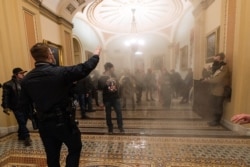A new look at current and former members of the U.S. military linked to extremist plots finds the numbers have tripled, due in large part to a series of recent events such as the January 6 riot at the U.S. Capitol, which helped mobilize extremists in general.
The analysis by the University of Maryland’s National Consortium for the Study of Terrorism and Responses to Terrorism (START), released Wednesday, looked at 354 individuals with military backgrounds charged or convicted of criminal acts linked to extremist ideology.
It found the average number of cases jumped from six per year from 1990 through 2010 to almost 21 cases per year over the past decade. The increase was largely driven by spikes in 2017, 2020 and 2021.
“Each of these years were marked by issues that mobilized comparatively large numbers of U.S. extremists,” the study said. “These include the Unite the Right rally in Charlottesville in 2017; the COVID-19 pandemic, racial justice protests, and U.S. presidential election in 2020; and the Capitol breach of January 6, 2021.”
It found that of those events, the biggest driver was the siege of the U.S. Capitol by supporters of then-President Donald Trump attempting to prevent the certification of Democrat Joe Biden’s election.
Almost 15% of the 563 individuals facing charges in connection with the siege have connections to the U.S. military, though the analysis said the vast majority were no longer serving as active-duty members of the military at the time.
The START study further concluded that more than 78% of those with military backgrounds who were connected to extremist plots were no longer serving in the military when they radicalized or were arrested.
“The majority of extremists in the U.S. do not have military backgrounds,” Michael Jensen, a co-author, said in a release about the report’s findings. “Of those that do, most of the individuals in our data radicalized after they left the military. So, when we talk about the problem of extremists with military backgrounds, this is primarily a problem among veterans.”
Consistent with earlier reports
The findings of the new START analysis appear to be consistent with previous reports looking at extremism within the ranks of the U.S. military.
Research by the Center for Strategic and International Studies (CSIS) published in April found that the number of active-duty or reserve U.S. military personnel involved in such terrorist plots or attacks was small but rising.
“The data should serve as a cautionary tale,” CSIS wrote at the time. “These challenges will persist, since extremist networks seek to embed their members in the military and law enforcement agencies and to actively recruit current and retired personnel.”
U.S. Defense Secretary Lloyd Austin has made combating extremism within the ranks a top priority. In April, he issued a memorandum calling for immediate changes to prevent extremist groups from infiltrating the military, as well as for increased training for personnel who are preparing to leave military service.
“The vast majority of those who serve in uniform and their civilian colleagues do so with great honor and integrity, but any extremist behavior in the force can have an outsized impact,” Austin wrote.
Pentagon officials say they have evidence that extremist groups have tried to infiltrate the military services and recruit active-duty members.
But at least one effort to track the extent to which extremists have burrowed into the U.S. military has run into trouble.
A report by the acting Defense Department inspector general said the work of a new military watchdog has been plagued by funding shortfalls and potential conflicts of interest.

